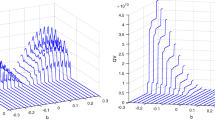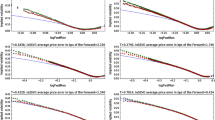Abstract
As the Heston model is not consistent with VIX data in real market well enough, alternative stochastic volatility models including the double-mean-reverting model of Gatheral (in: Bachelier Congress, 2008) have been developed to overcome its limitation. The double-mean-reverting model is a three factor model successfully reflecting the empirical dynamics of the variance but there is no closed form solution for VIX derivatives and SPX options and thus calibration using conventional techniques may be slow. In this paper, we propose a fast mean-reverting version of the double-mean-reverting model. We obtain a closed form approximation for VIX derivatives and show how it is effective by comparing it with the Heston model and the double-mean-reverting model.







Similar content being viewed by others
Notes
The data for VIX and its derivatives can be found at the following sites: https://www.cboe.com/products/vix-index-volatility/vix-options-and-futures/vix-index/vix-historical-data, http://cfe.cboe.com/market-data/historical-data, https://datashop.cboe.com.
References
Adrian, T., Rosenberg, J.: Stock returns and volatility: pricing the short-run and long-run components of market risk. J. Finance 63(6), 2997–3030 (2008). https://doi.org/10.1111/j.1540-6261.2008.01419.x
Andersen, T.G., Bollerslev, T., Diebold, F.X., Ebens, H.: The distribution of realized stock return volatility. J. Financ. Econ. 61(1), 43–76 (2001). https://doi.org/10.1016/S0304-405X(01)00055-1
Bates, D.S.: Maximum likelihood estimation of latent affine processes. Rev. Financ. Stud. 19(3), 909–965 (2006). https://doi.org/10.1093/rfs/hhj022
Bayer, C., Gatheral, J., Karlsmark, M.: Fast Ninomiya–Victoir calibration of the double-mean-reverting model. Quant. Finance 13(11), 1813–1829 (2013). https://doi.org/10.1080/14697688.2013.818245
Brenner, M., Galai, D.: New financial instruments for hedge changes in volatility. Financ. Anal. J. 45(4), 61–65 (1989). https://doi.org/10.2469/faj.v45.n4.61
Brigo, D., Mercurio, F.: Interest Rate Models-Theory and Practice: With Smile, Inflation and Credit. Springer, Heidelberg (2007)
Brockhaus, O., Long, D.: Volatility swaps made simple. Risk 13(1), 92–95 (2000)
Carr, P., Madan, D.: Towards a theory of volatility trading. Volatility New Estim. Tech. Pricing Deriv. 29, 417–427 (1998)
Chernov, M., Gallant, A.R., Ghysels, E., Tauchen, G.: Alternative models for stock price dynamics. J. Econom. 116(1), 225–257 (2003). https://doi.org/10.1016/S0304-4076(03)00108-8
Christoffersen, P., Heston, S., Jacobs, K.: The shape and term structure of the index option smirk: why multifactor stochastic volatility models work so well. Manag. Sci. 55(12), 1914–1932 (2009). https://doi.org/10.1287/mnsc.1090.1065
Folland, G.B.: Real Analysis: Modern Techniques and Their Applications. Wiley, New York (2013)
Fouque, J.P., Papanicolaou, G., Sircar, R., Sølna, K.: Multiscale Stochastic Volatility for Equity, Interest Rate, and Credit Derivatives. Cambridge University Press, Cambridge (2011)
Fouque, J.P., Saporito, Y.F., Zubelli, J.P.: Multiscale stochastic volatility model for derivatives on futures. Int. J. Theor. Appl. Finance 17(07), 1450, 043 (2014). https://doi.org/10.1142/S0219024914500435
Fouque, J.P., Lorig, M., Sircar, R.: Second order multiscale stochastic volatility asymptotics: stochastic terminal layer analysis and calibration. Finance Stochast. 20(3), 543–588 (2016)
Gallant, A.R., Hsu, C.T., Tauchen, G.: Using daily range data to calibrate volatility diffusions and extract the forward integrated variance. Rev. Econ. Stat. 81(4), 617–631 (1999). https://doi.org/10.1162/003465399558481
Gatheral, J.: Consistent modeling of SPX and VIX options. In: Bachelier Congress, p. 3 (2008)
Gauthier, P., Possamaï, D.: Efficient simulation of the double Heston model. J. Comput. Math. 4(3), 23–73 (2011). https://doi.org/10.2139/ssrn.1434853
Huang Jz, WuL: Specification analysis of option pricing models based on time-changed Levy processes. J. Finance 59(3), 1405–1439 (2004). https://doi.org/10.1111/j.1540-6261.2004.00667.x
Lu, Z., Zhu, Y.: Volatility components: the term structure dynamics of vix futures. J. Futures Mark. 30(3), 230–256 (2010). https://doi.org/10.1002/fut.20415
Oksendal, B.: Stochastic Differential Equations: An Introduction with Applications. Springer, Berlin (2013)
Papanicolaou, G., Fouque, J.P., Solna, K., Sircar, R.: Singular perturbations in option pricing. SIAM J. Appl. Math. 63(5), 1648–1665 (2003). https://doi.org/10.1137/S0036139902401550
Rouah, F.D.: The Heston Model and Its Extensions in MATLAB and C#. Wiley, Hoboken (2013)
Whaley, R.E.: Derivatives on market volatility: hedging tools long overdue. J. Deriv. 1(1), 71–84 (1993). https://doi.org/10.3905/jod.1993.407868
Acknowledgements
We thank the anonymous reviewers and the editor for their valuable comments and suggestions to improve the paper. The author J.-H. Kim gratefully acknowledges the financial support of the National Research Foundation of Korea NRF-2017R1A2B4003226.
Author information
Authors and Affiliations
Corresponding author
Appendix
Appendix
This appendix is devoted to prove the price approximation (3) with the approximation error, stated in Sect. 3, using the asymptotic analysis of Fouque et al. [12]. Without loss of generality, the interest rate r is assumed to zero here (so, \(D\left( \tau \right) \) is omitted), which makes it possible to price VIX futures and options consistently. Once pricing formulas are derived, the original prices can be obtained just by discounting the results.
First, applying the Feynman–Kac theorem (cf. [20]) to \(P^{\epsilon }\), we obtain a singularly perturbed partial differential equation given by
where
Then the expansion \(P^{\epsilon }=P_{0}+\sqrt{\epsilon }P_{1}+\epsilon P_{2}+\cdots \) gives
We have the equation \(\mathcal {L}_{0}P_{0}=0\) from the \(\frac{1}{\epsilon }\)-order term. This equation leads to the following solution (which depends on \(\alpha \)):
for \(1/2<\alpha <1\),
for \(\alpha =1/2\), and
for \(\alpha =1\). Then, from the growth condition (cf. Sect. 3) assumed for the VIX derivative price (2), the above \(c_{1}(t,z)\) must be zero. So, \(P_{0}\) is independent of y. Similarly, the equation  from the \(\frac{1}{\sqrt{\epsilon }}\)-order terms gives a result that \(P_{1}\) is also independent of y. Then the following Poisson equation is obtained from the \(\epsilon ^{0}\)-order terms:
from the \(\frac{1}{\sqrt{\epsilon }}\)-order terms gives a result that \(P_{1}\) is also independent of y. Then the following Poisson equation is obtained from the \(\epsilon ^{0}\)-order terms:
Its solvability condition (cf. [12]) is \(\left\langle \mathcal {L}_{2}P_{0}\right\rangle = \left\langle \mathcal {L}_{2}\right\rangle P_{0} = 0\), where \(\left\langle \,.\,\right\rangle \) denotes expectation with respect to the invariant distribution of \(Y_{t}\) (cf. Remark below for the explicit formula of the invariant distribution). Since \(P_{0}\) and the operator \(\mathcal {L}_{2}\) do not depend on y, \(\left\langle \mathcal {L}_{2}\right\rangle P_{0} =0\) leads to
Now, we substitute the expansion of \(P^{\epsilon }\) into (2) and obtain
Letting \(\epsilon \) go to zero, we obtain
where \(\tilde{h}_{0}:=\underset{\epsilon \rightarrow 0}{\lim }h^{\epsilon }\), \(h_{0}:=\int _{0}^{\infty }\tilde{h}_{0}\left( u,\cdot \right) \phi _{v}^{*}\left( u\right) du\), \(\phi _{y,z}\left( \,\cdot \,|Z_{T}=v\right) \) is the conditional density function of \(Y_{T}\) given \(Z_{T}=v\), \(Y_{t}=y\) and \(Z_{t}=z\), \(\phi _{v}^{*}\) is the invariant density function of \(Y_{T}\) given \(Z_{T}=v\), and \(\psi _{z}\) is the density function of \(Z_{T}\) given \(Z_{t}=z\). Here, the bounded convergence theorem (cf. Folland [11]) has been applied to change the limit and the integral. Knowing that the operator \(\mathcal {L}_{2}-\partial _{t}\) is the infinitesimal operator of the CIR process \(Z_{t}\), the Feynman–Kac theorem says that Eq. (9) implies the terminal condition \(P_{0}\left( T,z\right) =h_{0}\left( z\right) \). Also, one can express \(P_{0}\) as a single integral of the Heston price type integrand given by
where
and \(f\left( \nu ;k,\lambda \right) \) is a probability density function of non-central chi-square distribution with \(k=\frac{4c\theta }{\sigma _{z}^{2}}\) degrees of freedom and the non-centrality parameter \(\lambda =\frac{z\mathrm{e}^{-c\tau }}{\gamma }\). Note that
or
where \(\mathrm{VIX}_{T}^{*}=\sqrt{a_{2}^{*}Z_{T}+a_{3}^{*}\theta }\times 100\), \(a_{2}^{*}=\frac{1}{c\varDelta T}\left( 1-\mathrm{e}^{-c\varDelta T}\right) \) and \(a_{3}^{*}=1-a_{2}^{*}\). This means that \(P_{0}\) is exactly the same as the VIX derivative price of the Heston model.
In what follows, we calculate the first-order correction term \(P_{1}\). Because \(\mathcal {L}_{0}P_{2}=0\) is obtained from (6) and (7), \(P_{2}\) is independent of y also. Then, applying the solvability condition to the equation  , which comes from the \(\sqrt{\epsilon }\)-order terms, gives
, which comes from the \(\sqrt{\epsilon }\)-order terms, gives
The terminal condition for this PDE is found by utilizing (8). If subtracting \(P_{0}\) from the both sides of equation (8) and dividing it with \(\sqrt{\epsilon }\), we have
Letting \(\epsilon \) go to zero, we obtain
where \(\tilde{h}_{1}:=\underset{\epsilon \rightarrow 0}{\lim }\frac{h^{\epsilon }\left( u,v\right) -\tilde{h}_{0}\left( u,v\right) }{\sqrt{\epsilon }}\) and \(h_{1}:=\int _{0}^{\infty }\tilde{h}_{1}\left( u,\cdot \right) \phi _{v}^{*}\left( u\right) du\). Then we have
In fact, one can extend the results for \(P_0\) and \(P_1\) to all \(P_{i}\) for \(i\ge 2\) by induction and obtain
and they all are independent of y because \(\mathcal {L}_{0}P_{i}=0\) holds. At first glance, it might look strange because VIX derivatives are certainly affected by the process \(Y_t\). However, the perturbation theory used in our model framework may not reflect the current value y of the fast mean-reverting variance directly. Its mean level z (the intermediate-term variance) is a major factor of the price. Recall \(\mathrm{VIX}_{T}^{2}=a_{1}Y_{T}+a_{2}Z_{T}+a_{3}\theta \). For the calibration purpose, this is desirable in the sense that it is difficult to observe the short-term value of volatility whereas it may not be the case with its mean level. Even if there is no explicit dependence of each term \(P_i\) on y, we note that the dependence on the parameters \(\alpha \) and \(\nu \) controlling the process \(Y_t\) can be identified through the invariant distribution \(\phi ^*_z\) which is given by Remark at the end of this appendix.
Now, we explain how to obtain each \(h_{i}\). We first note that \(\tilde{h}_{i}\) is defined in such a way that \(h^{\epsilon }=\tilde{h}_{0}+\sqrt{\epsilon }\tilde{h}_{1}+\epsilon \tilde{h}_{2}+\cdots \) holds, which leads to the idea that \(\tilde{h}_{i}\) could be easily derived by deploying the Talyor expansion associated with \(h^{\epsilon }\). By the definitions of \(a_{1}\) and \(a_{2}\) in Sect, 2, \(a_{1}u+a_{2}v+a_{3}\theta =a_{2}^{*}v+a_{3}^{*}\theta +\left( ca_{2}^{*}\left( v-\theta \right) +\frac{1}{\varDelta T}\left( u-v\right) \right) \epsilon +O\left( \epsilon ^{2}\right) \) for some variables u and v. So, for a given (regularized) payoff H, \(h^{\epsilon }\left( u,v\right) \) can be expanded as follows:
where \(\tilde{H}\left( x\right) :=H\left( 100\sqrt{x}\right) \) is a single variable function. This implies
and \(\tilde{h}_{i}\left( u,v\right) =0\) for every odd number i. So, we obtain \(h_{0}\) and \(h_{2}\) given by
respectively and \(h_{i}\left( v\right) =0\) for every odd number i. Here, \(\int _{0}^{\infty }u\phi _{v}^{*}\left( u\right) du=v\) has been used for \(h_{2}\). It is notable that \(P_{i}=0\) for every odd number i. Particularly, \(P_{1}=0\) and \(P_{3}=0\) improve the accuracy of our approximation. Specific forms of \(h_{i}\) for each VIX derivative are obtained by applying this method to the corresponding payoff H given by
-
VIX futures: \(H\left( x\right) =x\)
-
VIX call option: \(H\left( x\right) =\left( x-K\right) \varvec{1}_{\left\{ x\ge K\right\} }\)
-
VIX put option: \(H\left( x\right) =\left( K-x\right) \varvec{1}_{\left\{ x\le K\right\} }\)
-
VIX binary call option: \(H\left( x\right) =\varvec{1}_{\left\{ x\ge K\right\} }\)
-
VIX binary put option: \(H\left( x\right) =\varvec{1}_{\left\{ x\le K\right\} }\)
Here, K is the strike of an option.
Next, we discuss the accuracy of the price approximation \(\tilde{P}^{\epsilon }\left( =P_{0}+\epsilon P_{2}\right) \) for the futures. One can do it similarly for the options. For convenience, let \(\hat{P}^{\epsilon }:=\tilde{P}^{\epsilon }+\epsilon ^{2}P_{4}+\epsilon ^{2}\sqrt{\epsilon }P_{5}\), \(R^{\epsilon }:=P^{\epsilon }-\hat{P}^{\epsilon }\) and \(\mathcal {L}^{\epsilon }:=\frac{1}{\epsilon }\mathcal {L}_{0}+\frac{1}{\sqrt{\epsilon }}\mathcal {L}_{1}+\mathcal {L}_{2}\). Then
and so from (5) we have
where \(R^{\epsilon }\) has the terminal condition
Then, from the Feynman-Kac theorem (probabilistic representation), we have
Here, the first term of the right hand side is convergent in the sense that
where \(b_{1}^{*}\) and \(b_{2}^{*}\) are given by
respectively, and
for some bounded function \(C_{1}\). Here, all the moments of \(Y_{T}\) with respect to invariant distribution of \(Y_{t}\) are assumed to be well-defined. Hence, there is a bounded function \(C_{2}\left( t,y,z\right) \) independent of \(\epsilon \) such that
Consequently, \(\left| R^{\epsilon }\left( t,y,z\right) \right| \le C_{3}\left( t,y,z\right) \epsilon ^{2}\) for some bounded function \(C_{3}\left( t,y,z\right) \) independent of \(\epsilon \) and thus
for some bounded function \(C\left( t,y,z\right) \) independent of \(\epsilon \).
Remark
The invariant distributions \(\phi ^*_z\) of the mean-reverting process \(Y_t\) given \(Z_{t}=z\) for various \(\alpha \) are as follows.
-
\(\alpha =1\):
$$\begin{aligned} \phi ^*_z\left( y\right) =\frac{\zeta ^{\eta }}{\Gamma \left( \eta \right) } \frac{e^{-\zeta /y}}{y^{1+\eta }}, \end{aligned}$$which is a density of the inverse gamma distribution with shape parameter \(\eta =1+1/\nu ^{2}\) and scale parameter \(\zeta =z/\nu ^{2}\).
-
\(\alpha =\frac{1}{2}\):
$$\begin{aligned} \phi ^*_z\left( y\right) =\frac{1}{\nu ^{2\theta }\Gamma \left( \theta \right) } y^{\theta -1}e^{-y/\nu ^{2}}, \end{aligned}$$which is a density of the gamma distribution with shape parameter \(\theta =z/\nu ^{2}\) and scale parameter \(\nu ^{2}\).
-
\(\frac{1}{2}<\alpha <1\):
$$\begin{aligned} \phi ^*_z\left( y\right) =\frac{1}{Cy^{2\alpha }}\mathrm{exp}\left( \frac{z}{\nu ^{2}\left( 1-2\alpha \right) }y^{1-2\alpha }-\frac{1}{\nu ^{2}\left( 2-2\alpha \right) }y^{2-2\alpha }\right) , \end{aligned}$$where C is a constant such that \(\int _{0}^{\infty }\phi ^*_z=1\) holds.
Rights and permissions
About this article
Cite this article
Huh, J., Jeon, J. & Kim, JH. A scaled version of the double-mean-reverting model for VIX derivatives. Math Finan Econ 12, 495–515 (2018). https://doi.org/10.1007/s11579-018-0213-8
Received:
Accepted:
Published:
Issue Date:
DOI: https://doi.org/10.1007/s11579-018-0213-8




